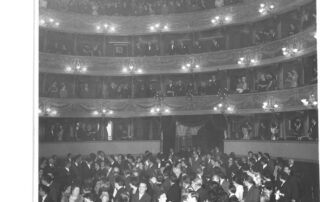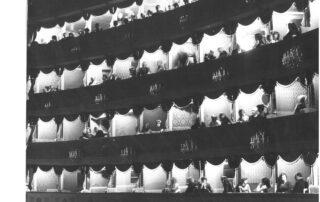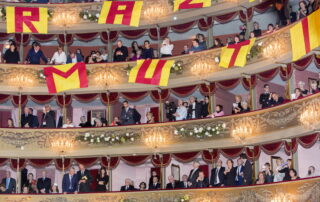Equipped with 106 boxes and 2 galleries, the Donizetti is an Italian-style theater.
The city theater, however, lacks one of the typical characteristics of theaters that call themselves under this name. The boxes, in fact, are all the same; there is no real one.
A large central double stage reserved for the authorities, the so-called palchettone, was even there in the wooden provisional theaters, but at the time of construction Bortolo Riccardi, builder and owner of the theater, thought better of not making it in order to make the most of all the space and sell as many boxes as possible.
Despite complaints from the authorities of Venice, Bergamo’s master for centuries, the French at the time of Napoleon and even the Austrians in 1815, no one ever built it.
In the late 1700s, throughout the 1800s and even into the 1900s owning a stage at the theater was a sign of distinction, it allowed one to have a private space to be considered as a place in the house, always at one’s disposal where one could welcome guests and share the show with them.
The economic value of a box and the social prestige related to it were valued according to location, with absolute preference for those central to the 1st and 2nd order.
Unlike today, a dressing room was attached to the stage proper: a small room adjacent to the one facing the hall where servants heated food or kept provisions.
It was an absolutely private place, as the stage could be when the curtains were drawn.
Thus there were spaces for official life and even for the more private.
The owners of the stage have always been there, ever since 1790, when the builder Riccardi, in order to make money, sold the property.
Those who bought were, of course, the nobles and well-to-do of Bergamo: from the Scotti, to the Suardo, to the Camozzi, to the Venier.
The ownership of the boxes has always been grafted onto the more general ownership of the theater: even when in 1938 the theater passed to the City of Bergamo, not all the boxes became public property and today this is still the case, but thanks to an agreement the use is granted to the entire public.
The Donizetti’s stages have hosted important personalities such as President of the Republic Mattarella, who in 2016 came to celebrate Riccardo Muti’s 50-year career.
They have seen performances that caused a sensation, such as the first two jazz concerts in the 1950s, but also events that have marked the history of the theater: above all, in 1840, when Gaetano Donizetti received a triumphant tribute from the city on the occasion of his L’Esule di Roma.
Big events, but also small episodes made up of judgments, chatter, and comments.
GLIMPSES AND CORNERS TO DISCOVER IN THE CORRIDORS OF THE BOXES Outside the boxes, in the corridors of the three tiers, some spaces set up with objects related to the history and works of the theater can be reached.
Glimpses for the audience to admire historical posters and furnishings and to grasp, through some stage costumes, the skill of the theater workers and the beauty of the clothes they made.
In the center of the third tier of boxes, a small salon is dedicated to two great queens, Anna Bolena and Maria Stuarda, the darlings of two masterpieces by Gaetano Donizetti, evoked through the display of historical posters.
Also not to be missed is the Gallery of Mirrors, between the 2nd and 3rd rows of boxes on the right.
A wall enriched with mirrors from the furnishings of the private boxes.
The density of objects and the multiplicity of forms recall a true antique picture gallery.





